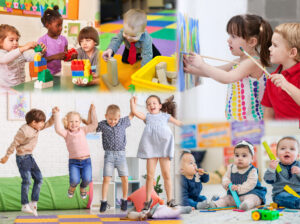
Columnist Nozaina : A child’s work is play. Play is essential for children’s development. Play offers a chance for parents to connect with their children because they are their first teachers, and much of teaching happens through play. Play helps children learn family rules and how to act in society as they grow. Parents need to play with their children. You are engaging in a play when your baby starts to smile, and you smile back. Play is spontaneous and enjoyable. Play helps children to learn cognitive thinking, social, and motor skills. Provide a setting for your child to play with others because children learn by playing with others. As children grow, provide toys and sports equipment to play with others. Children must learn to play throughout life. Play helps in the healthy development of the child.
According to the research, 75 percent of brain development occurs after birth, and play helps with that development by stimulating the brain. This process supports the development of gross and fine motor skills. Gross motor skills are movements such as running or jumping. Fine motor skills are movements such as holding a pencil or toy. Play also helps to develop socialization and language skills. Children learn to communicate, solve problems, be creative, and think. In today’s world, parents find it difficult to have quality time with their children because they cannot balance work and home schedules. Parents must spend quality time with their children because they are their first teachers. Your child needs time with you to play and relax. Playing builds lasting bonds between parents and children.
It allows parents to appreciate the uniqueness of each child and can also be a stress reducer. When a parent plays a board game with a child, plays baseball, reads a story, or shares a bike ride, the child learns self-importance. Today, children use technology such as mobiles and computers. They spend most of their time using technology and are not active physically or using their imagination. Parents can help to reduce the screen time of their child. Limit screen time to no more than two hours per day. Children need to get physical exercise for a minimum of one hour daily. You can encourage play by providing motivating materials that promote learning and exploration.
Types of Play
Unoccupied Play: This is the initial form of playing. From birth to three months, the child is busy in unoccupied play. Children seem to be making random actions with no specific purpose.
Solitary Play: This play starts in infancy and is common in toddlers. From 3 to 18 months, children spend much of their time playing on their own. Children are very busy with play and may not notice other children playing or sitting nearby during this play. They explore their worlds by grabbing, watching, and rattling objects.
Onlooker Play: This happens often during the toddler years when the child notices other children playing. Children learn language and learn how to relate to others. Onlooker play usually begins during toddler years but can happen at any age.
Parallel Play: From 18 months to 2 years, children start playing next to other children without any interaction. Parallel play provides toddlers with chances for role-playing.
Associative Play: When children are around 3 to 4 years of age, they become more interested in other children than the toys. Children start socializing with other children. Associative play is sometimes stated as ‘loosely organized play’. This play helps children learn the do’s and don’ts of getting along with others. Associative play encourages language development and teaches the art of sharing, cooperation, and problem-solving. In this play, children do not set the rules. The groups of children have similar goals. They all want to play with the same types of toys.
Social Play: At the age of 3, children begin to socialize with other children. Through interaction with other children in a play setting, they learn social rules such as give-and-take cooperation. Children can share ideas and toys.

Motor – Physical Play: Children engage in physical play when they jump, run, and play games such as hide and seek. This play offers a chance for children to develop muscle strength and exercise. Physical play teaches social skills while enjoying good exercise. Your child learns to accept losing or winning and to take turns.
Constructive Play: This type of play begins in infancy and becomes more complex as a child grows. In constructive play, children create things. Children start playing in sand, building blocks, and drawing. Constructive play allows children to discover patterns to find what does not work and what works and explore objects. Children gain pride when they complete a task during play.
Expressive Play: This type of play helps children learn to express feelings. Parents can give them various materials such as markers, colored pencils, crayons, and paints for writing and drawing. Rhythm instruments, beanbags, and pounding benches are other sources of toys for expressive play.
Fantasy Play: Children learn to try new situations and experiment with emotions and language with fantasy play. They learn to think. Children assume adult roles and learn to think in abstract methods. They stretch their imaginations and use new numbers and words to express dreams, history, and concepts.
Play is the first chance for a child to discover the world in which he/she lives.
Play allows them to test their opinions about the world.
Children also copy their own family experiences.
Children increase their problem-solving abilities through puzzles and games.
Children strengthen their language skills by modeling other adults and children.
Playing house helps them to create stories about their roles, such as ‘I am the father’.
Children gain an understanding of texture, size, and shape through play. It helps them to learn links as they try to put a round object in a round opening.
Toys, books, and games that show matching words and pictures add to a child’s vocabulary. Play lets children be creative while developing their imagination.
Children learn to remember, think, and solve problems. They gain knowledge through their play.